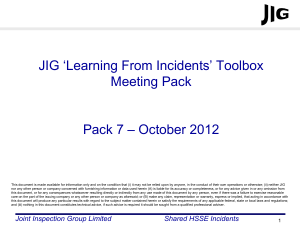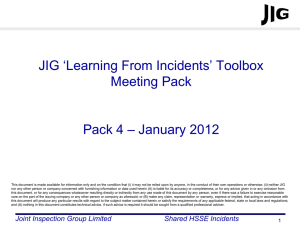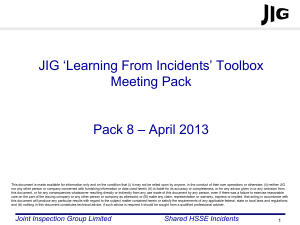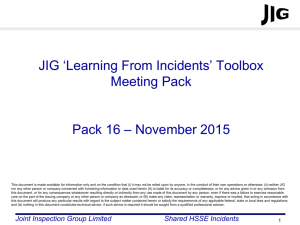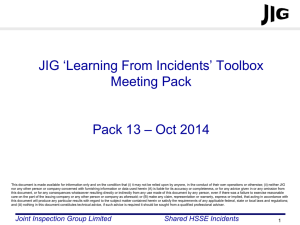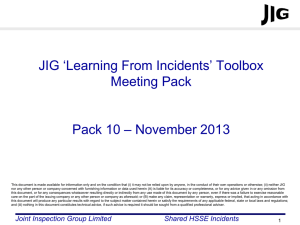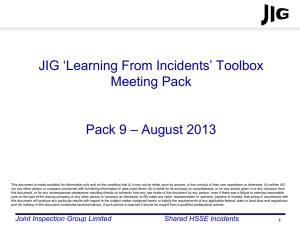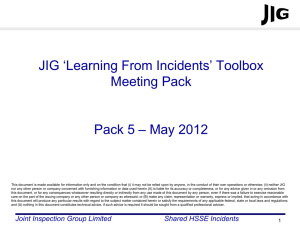Joint Inspection Group Limited Shared HSSE Incidents
advertisement
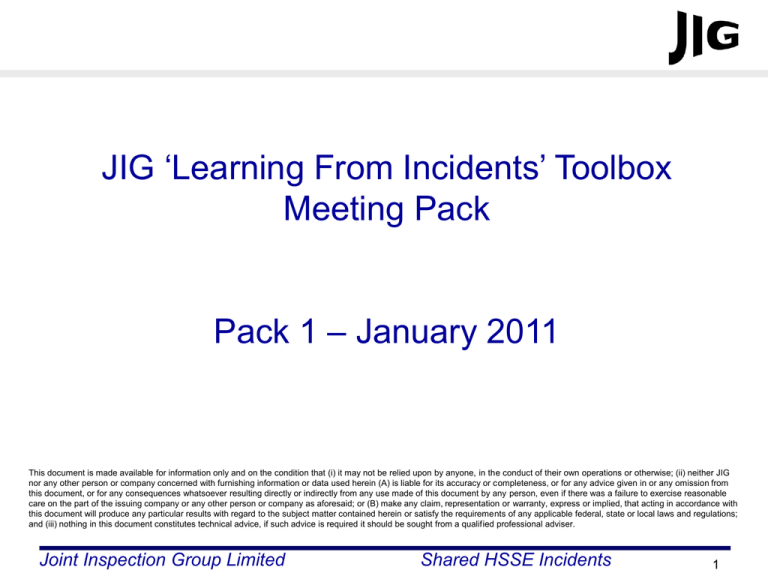
JIG ‘Learning From Incidents’ Toolbox Meeting Pack Pack 1 – January 2011 This document is made available for information only and on the condition that (i) it may not be relied upon by anyone, in the conduct of their own operations or otherwise; (ii) neither JIG nor any other person or company concerned with furnishing information or data used herein (A) is liable for its accuracy or completeness, or for any advice given in or any omission from this document, or for any consequences whatsoever resulting directly or indirectly from any use made of this document by any person, even if there was a failure to exercise reasonable care on the part of the issuing company or any other person or company as aforesaid; or (B) make any claim, representation or warranty, express or implied, that acting in accordance with this document will produce any particular results with regard to the subject matter contained herein or satisfy the requirements of any applicable federal, state or local laws and regulations; and (iii) nothing in this document constitutes technical advice, if such advice is required it should be sought from a qualified professional adviser. Joint Inspection Group Limited Shared HSSE Incidents 1 Learning From Incidents How to use the JIG ‘Learning From Incidents’ Toolbox Meeting Pack • The intention is that these slides promote a healthy, informal dialogue on safety between operators and management. • Slides should be shared with all operators (fuelling operators, depot operators and maintenance technicians) during regular, informal safety meetings. • No need to review every incident in one Toolbox meeting, select 1 or 2 incidents per meeting. • The supervisor or manager should host the meeting to aid the discussion, but should not dominate the discussion. Joint Inspection Group Limited Shared HSSE Incidents 2 Learning From Incidents For every incident in this pack, ask yourselves the following questions: • Can we apply the lessons learnt from this incident and is there potential for a similar type of incident at our site? • Do our risk assessments identify and adequately reflect these incidents? • Are our prevention measures in place and effective (procedures and practices)? • Are our mitigation measures in place and effective (safety equipment, emergency procedures)? • What can I do personally to prevent this type of incident? Joint Inspection Group Limited Shared HSSE Incidents 3 UST Hot Work Fatality (LFI 2010-1) Incident Summary - A subcontractor removed two petrol and one diesel Underground Storage Tanks (USTs), as part of a routine site closure project. The subcontractor started to cut up the tanks onsite. No work permits were issued for this process. Diesel truck exhaust was used to degas the tanks (unapproved degassing method) and no gas testing was conducted. The first tank was successfully cut without incident; however, when the welder began cutting the second tank, an explosion occurred. This explosion resulted in one fatality, two workers hospitalized with burns and one first aid case. Root Causes – Subcontractor performed high risk out-of-scope work. Did not follow procedures for tank degassing and demolition. Gas testing was not conducted. No pre-job safety briefing, risk assessment, or job-safety analysis was conducted. Insufficient oversight of subcontractor Lessons Learnt – High risk work to be performed only if within contract’s scope-of-work. Stop Work Authority needs to be effectively cascaded to subcontractor workforce. Critical equipment (gas tester in this case) should always be available, functioning and used. Robust verification and validation of adherence to policies and procedures is required at both the contractor and subcontractor level. Contracted work at remote locations has a higher risk profile and potential risks need to be assessed, communicated, and mitigated. Can you think of any similar situations that YOU have experienced or witnessed? Did you report it? Joint Inspection Group Limited Tank that exploded Tank end that struck and killed subcontract worker Shared HSSE Incidents 4 Fueller MVC Spill (LFI 2010-2) Incident Summary - A crewman left a Fuels Depot to supply jet fuel to an International Airport that was 2 miles away. While manoeuvring through the entrance gate at the airport, the trailer unit hit the vertical gate support. The driver was notified by airport personnel at the site that the trailer made contact with the gate. Upon getting down from the vehicle cab he observed a scratch and dent on the rear right-side of the trailer where a small hole had been created from which product was seeping out. He stopped the leakage with a temporary nylon plug and then notified the Fuels Depot. He did not await instructions, however, and instead immediately drove back to the Depot. Upon returning, the trailer then hit the Depot gate support beam while the driver was attempting to manoeuvre through the entrance gate. This had the effect of widening the existing rupture in the Trailer. Product gushed from the trailer onto the concrete depot forecourt. The resulting spill was contained with spill trays and sand. Root Causes – • Drivers did not communicate the airport gate change to management; consequently, the risks were not addressed and shared with all depot crewmen. • The drivers actions after the initial collision contradicted the Emergency Response Plan. • After the initial incident, the driver was anxious to return to the Depot and took the wrong angle of approach and did not use his mirrors while driving through the Depot gate. • The driver was found to have poor eyesight, this was not identified during periodic eye tests. Lessons Learnt – • Journey Plans must be updated frequently to address new risks • Need to provide periodic refresher training on emergency response procedures with emphasis on effective communication. • Confirm if driver's vision exam provided under Fitness for Duty is adequate. Can you think of any similar situations that YOU have experienced or witnessed? Did you report it? Joint Inspection Group Limited Shared HSSE Incidents 5 Personal Injury (LFI 2010-4) Incident Summary - An operator bumped his head on the centre tank vent of an A-320 aircraft whilst walking under the aircraft to access the fuel panel. The operator took a different route than normal under the aircraft because he was concerned that the deadman cable would become tangled in the aircraft wheels. The operator was wearing a bump cap and sustained a small red mark to the head, a slight headache and pain in their neck for a short period. When back in the depot the operator applied ice to the affected area. The operator did not need to visit a doctor and was able to continue performing all normal work duties. Discussion Points • If the operator in this case had not been wearing a bump cap, what injuries could he have sustained? • What hazards do you consider when you have to walk underneath an aircraft? • Do you follow a safe route under the aircraft based on the hazards you identify in your last minute risk assessment? • Does your location have pre-defined safe routes for walking under aircraft? If so, do these take into account hot engine parts, hot air vents and bump hazards? Centre tank vent Can you think of any similar situations that YOU have experienced or witnessed? Did you report it? Joint Inspection Group Limited Shared HSSE Incidents 6 Fueller Strikes Aircraft Wing (LFI 2010-5) Incident Summary - An operator had positioned a fueller under the wing of an A321 aircraft in order to perform a platform fuelling. After completing a 360° Walkaround at the end of the fuelling, the operator realised that a luggage tractor was blocking his exit so he waited approximately 2 minutes in the cab until the luggage tractor moved. The operator failed to complete a second 360° Walkaround and did not realise that the aircraft wing-flaps were lowered. When the operator started to drive, the mirror bracket on the roof of the fueller cab contacted with the casing of the wing flap mechanism causing a 5cm crack. An aircraft technician inspected the damage and temporarily fixed it with metal tape. The aircraft departed after a 1 hour delay. The fueller cab sustained minor damage to the mirror bracket. Discussion Points – • Discuss why it may not be safe to drive a fuelling vehicle under the wing of an A-320 series aircraft – what could go wrong? • After doing your 360o Walkaround, if you are delayed in driving away do you repeat the 360o Walkaround in case the situation around you has changed? Damage to Aircraft • If the operator had looked up when doing his 360o Walkaround, do you think he would have noticed the danger? Damage to fueller mirror bracket Joint Inspection Group Limited Can you think of any similar situations that YOU have experienced or witnessed? Did you report it? Shared HSSE Incidents 7

